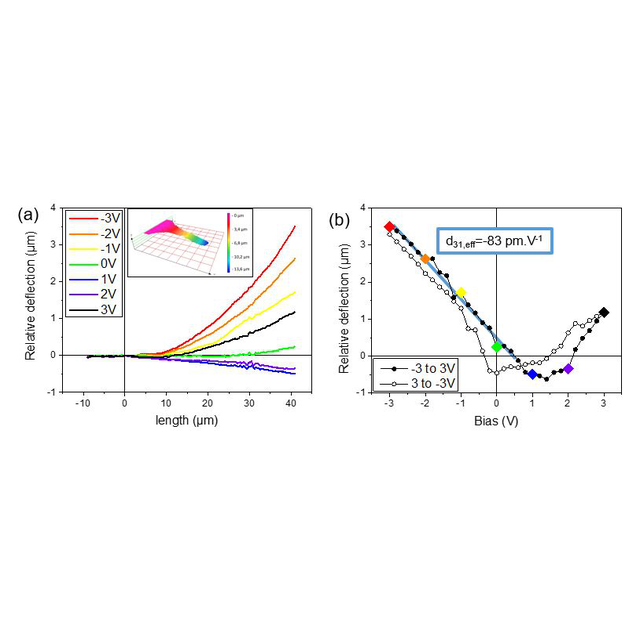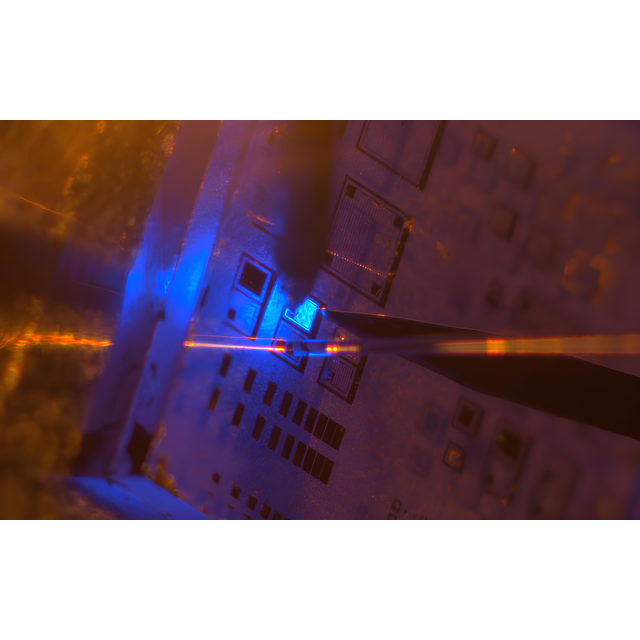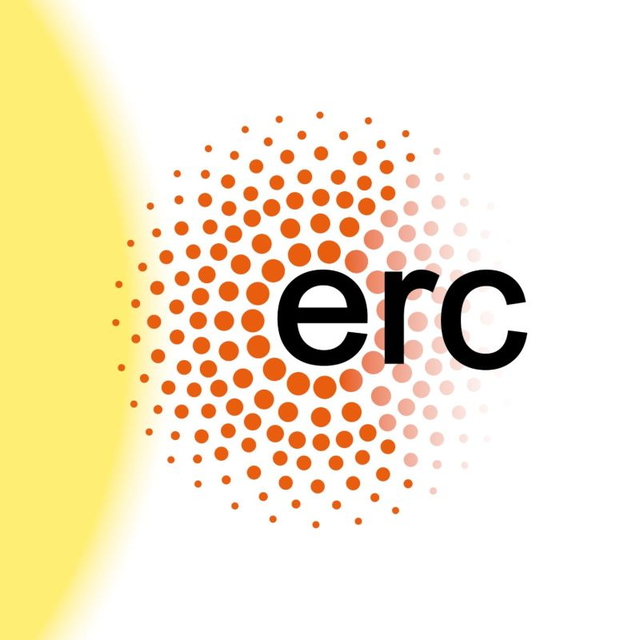Researchers from C2N, in collaboration with colleagues from Université de Picardie Jules Verne, have reported the first investigation of the piezoelectric response in epitaxial BiFeO3 MEMS (micro-electro-mechanical system). The devices demonstrate larger electromechanical performance than that of state-of-the-art piezoelectric cantilevers, including well-known PZT (Pb(Zr,Ti)O3) and PMN–PT (Pb(Mg1/3Nb2/3)O3-PbTiO3). This, combined with the low dielectric constant and lead-free composition, could potentially lead to a replacement of lead-based piezoelectrics by BiFeO3 in many microdevices.
The large switchable ferroelectric polarization and lead-free composition of BiFeO3 (BFO) make it a promising candidate as an active material in numerous applications, in particular, in micro-electro-mechanical systems (MEMS). For device applications with improved performance, BFO is preferred in a thin film form, epitaxially grown with particular crystalline orientations, showing robust ferroelectric and piezoelectric properties. The growth of BFO films on Si substrates is particularly important for the compatibility of the devices with Si—being the basis of semiconductor technology. Among MEMS, cantilevers using transverse piezoelectric response (31 modes) are the prototype device structures for actuation and sensing. Only a few studies have recently reported the integration of BFO films into cantilevers, and they were all focused on polycrystalline BFO films patterned into micrometers-thick cantilevers. The piezoelectric response of MEMS based on epitaxial BFO films has not been reported so far, while epitaxial thin films attract considerable attention in device applications because of their often superior properties over polycrystalline thin films. In this context, the integration of epitaxial BFO into microcantilevers and the investigation of their piezoelectric response particularly appear timely and of technological importance.
In this work, 200-nm-thick Mn-doped BiFeO3 thin films have been epitaxially grown by pulsed laser deposition (PLD) on (001) Si substrates using (001) SrRuO3/(001) SrTiO3 buffer layers. The films have been patterned into microcantilevers as prototype device structures for piezoelectric actuation. The devices demonstrate excellent ferroelectric response with a remanent polarization of 55 µC/cm2. The epitaxial BiFeO3 MEMS exhibit very high piezoelectric response with transverse piezoelectric coefficient d31 reaching 83 pm/V. The BiFeO3 cantilevers show larger electromechanical performance (the ratio of curvature/electric field) than that of state-of-art piezoelectric cantilevers, including well-known PZT (Pb(Zr,Ti)O3) and the hyper-active PMN–PT (Pb(Mg1/3Nb2/3)O3-PbTiO3). In addition, the piezoelectricity in BiFeO3 MEMS is found to depend on the ferroelectric polarization direction, with an observed asymmetry of 53% of the d31 coefficient with the voltage polarity. This asymmetric piezoresponse could originate from the flexoelectric effect, which would provide a first measurement of the flexoelectric coefficient µ in BFO (µ= -51 nC.m-1). In addition, this flexoelectric effect could be exploited to further enhance the electromechanical performance of the devices. These results show that by taking advantage of the low dielectric constant of BiFeO3, a promising alternative opens up to develop piezoelectric MEMS that currently incorporate conventional piezoelectric materials from the lead-based perovskite family.
Reference
High piezoelectricity in epitaxial BiFeO3 microcantilevers
Sylvia Matzen1, Stéphane Gable1, Nathan Lequet1, Said Yousfi2, Komalika Rani1, Thomas Maroutian1, Guillaume Agnus1, Houssny Bouyanfif2, Philippe Lecoeur1
Applied Physics Letters 121, 142901 (2022)
https://doi.org/10.1063/5.0105404
Affiliations
1 Centre for Nanoscience and Nanotechnology - C2N (CNRS, Paris-Saclay University), 91120 Palaiseau, France
2 Laboratoire de Physique de la Matière Condensée UR2081, Université de Picardie Jules Verne, 80000 Amiens, France
Contact C2N
Sylvia Matzen
Figure: (a) Deflection under applied voltage of a BiFeO3 cantilever. Inset: Optical profilometry 3D image. (b) Extraction of the piezoelectric coefficient
Keywords
epitaxial oxides, thin films, MEMS, piezoelectric properties









